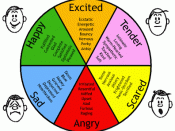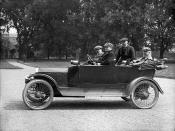Psychologists today increasingly view emotion as a safeguard of survival and an enrichment of experience throughout development. Emotional expression provides a powerful communication system, one that is especially important in the early childhood stage of life before language has been developed. As these developments proceed, voice, face, gesture, and posture continue to communicate feelings to others and to influence their behaviour.
Ways of expressing emotion may be either innate or culturally acquired. Certain facial expressions, such as smiling, have been found to be universal, even among blind persons, who have no means of imitating them. Other expressions vary across cultures. For example, the Chinese stick out their tongues to register surprise, in contrast to Americans and other Westerners, who raise their eyebrows and widen their eyes. In addition to the ways of communicating various emotions, people within a culture also learn certain unwritten codes governing emotional expression itself-what emotions can be openly expressed and under what circumstances.
Cultural forces also influence how people describe and categorise what they are feeling. An emotion that is commonly recognised in one society may be subsumed under another emotion in a different one. Some cultures, for example, do not distinguish between anger and sadness. Tahitians, who have no word for either sadness or guilt, have 46 words for various types of anger.
In daily life, emotional arousal may have beneficial or disruptive effects, depending on the situation and the intensity of the emotion. Moderate levels of arousal increase efficiency levels by making people more alert. However, intense emotions-either positive or negative-interfere with performance because central nervous system responses are channelled in too many directions at once. The effects of arousal on performance also depend on the difficulty of the task at hand; emotions interfere less with simple tasks than with more complicated ones.
In 1884, William James publishes an article in a philosophy journal. The article was named 'What is an emotion?'
James stated that emotion was a sequence of events that starts with stimulus and concludes with a feeling, a conscious emotional experience. The main question James focused on was 'Do we run from a bear because we are afraid or are we afraid because we run?
He proposed that the obvious answer, that we run because we are afraid, was incorrect and instead argued that we are afraid because we run:
"Our natural way of thinking about.... emotions is that the mental perception of some fact excites the mental affection called emotion, and that the latter state of mind gives rise to bodily expression. My thesis on the contrary is that the bodily changes follow directly the PERCEPTION of the exciting fact, and that our feeling of the same changes as they occur IS the emotion".
James. W (1884) What is an emotion? Mind 9, 188-205
Stimulus Response Feeling
(Bear) (Run) (Fear)
The essence of James proposal was simple. Emotions are often accompanied by bodily responses (increase in heartbeat, perspiring, erratic breathing). Since different emotions have different responses, the feedback to the brain is different and would, according to James, account for how we feel in such situations.
In 1885, Carl Lange independently proposed a theory, very similar to that of James. From then on, the theory became known as the James-Lange theory.
According to James the brain interprets a situation in such a way that physiological responses are called for, but the interpretation is not necessarily conscious until the physical responses occur. This subsequent perception of bodily responses constitutes the experience of emotion. So James's theory holds that these reflexive bodily responses precede the experience of emotion. The conscious aspect of emotion arises later, when the brain observes these reactions. According to James's theory there is no emotion generated solely by activity in the central nervous system therefore it suggests that the reason that people may have difficulty knowing their true feelings is that you must interpret them from your responses; there is no direct access to feelings from one part of the brain to another.
Cannon (1927) and Bard (1928) criticised the James -Lange theory on the basis that each emotion would need it's own distinct pattern of activity to the brain, otherwise the part of the brain dealing with emotions, the cortex, would not be able to determine which emotion should be 'felt'.
The Cannon-Bard theory claims that information sent to the cortex produces emotions at the same time as physiological and behavioural responses are produced. However, these are independent of one another. (Psychology: A New Introduction, pg357, Gross et al.)
External stimuli activate the thalamus, found in the fore brain, which acts as a kind of reception area for external stimuli. Which in turn sends sensory messages to the cortex for interpretation, simultaneously sending impulses to the Peripheral Nervous System (PNS) and visceral and skeletal muscles.
As research has shown, Cannon was incorrect to assume that the thalamus alone played a role in emotions. Other brain structures, for example, the hypothalamus and the limbic system also play large roles regarding emotions.
For James, emotional experience was determined by feedback to the brain from the bodily responses. But for Cannon emotions are defined by mind processes contained within the brain especially within the thalamus.
In the early 1960's, Stanley Schachter and Jerome Singer proposed a new solution to the James-Lange / Cannon -Bard debate. Schachter and Singer agreed that bodily feedback was very important in the emotion topic. They also believed Cannon was correct in stating that bodily feedback lacked specificity. (The Emotional Brain, Joseph Le Doux, 1998).
With the new arrival of the cognitive perspective, Schachter and Singe argued that cognitions filled the gap of the specificity of bodily responses and the specificity of the emotion felt. Because the theory proposes arousal and cognition, it is sometimes referred to as the two-factor theory.
Stimulus Arousal Cognition Feeling
Schachter and Singer conducted an experiment to investigate this idea.
They wanted to observe what happened when people experienced physical arousal, and how they would feel in different situations.
Male college students were informed that they were participating in an experiment looking at the effects of a vitamin compound 'Suproxin' on vision, and that they would have to receive an injection. The subjects were in fact given epinephrine (a hormone that increases heart rate, breathing rate, blood pressure and muscles spasms).
All participants were split into four groups.
The first group (epinephrine-informed group) were told the real effects of the 'vitamin'. Group two (epinephrine-misinformed group) were given the 'vitamin' and were misinformed about the effects. They were told that the 'vitamin' may make them feel itchy, numb or could cause headache. Group three (epinephrine ignorant group) were not given any information about the 'vitamin' they were being injected with. Group four, named the controlled condition, were given a saline injection so there would be no change in physiological arousal. Without physiological arousal would we be able to experience emotion?
After the participants had received his injection, they were separately taken to a waiting room and asked to wait for the vision test. Once there he participant was introduced to another participant (a stooge). With some participants the stooge pretended to fill in a questionnaire, as he completed the questions he acted angrily to the nature of he questions and loudly complained. After a while, he ripped up the questionnaire and stormed out of the 'waiting room'. With other participants, the stooge acted 'euphorically', fooling around making paper aeroplanes. After the stooge had left the room, participants were asked to fill out a questionnaire, which included questions about their emotional state.
The emotional responses of the participants were observed through a one-way mirror.
The results provided some support for Schachters theory, with participants showing emotional changes as predicted.
The participant's in-group one, the informed group, showed physiological arousal like anybody would who had been injected with epinephrine. The second factor, cognitive appraisal, was not present. These participants had an explanation for their arousal, the epinephrine.
Both the misinformed group and the ignorant group, showed the two factors in this experiment. Both cognitive appraisal and physiological arousal were present.
The controlled group showed neither of the factors. If the physiological factor were not present, participants wouldn't be able to change their emotional state, as arousal has to be present for the emotion to occur.
Findings that participants emotional states seemed to change irrespective of whether they were in he 'angry' or 'euphoric' condition is also important, because it supports the view that the type of physiological arousal can be associated with different emotions.
This theory was backed up by an interesting experiment conducted by Dutton and Aron (1974). The subjects were a group of unsuspecting males aged 18 - 35 who were visiting the Capilano Canyon in Canada. An attractive female experimenter approached the men and asked them some questions as part of a survey she was doing on scenic attractions. One of the things they were asked to do was to invent a short story based on a picture of a woman that could have been interpreted in different ways. This was later scored for the amount of sexual content, which was then taken to reflect the amount of attraction felt towards the interviewer.
Some men were interviewed on an extremely unstable suspension bridge 230 feet above the Canyon (seen as a high arousal situation) and others on a solid wooden bridge over a small stream(low arousal) The men on the unstable suspension bridge had stories containing significantly more sexual imagery than those on the low bridge.
According to the Schachter theory, the reason for this is that the men were experiencing physiological arousal (probably because of the dangerous bridge) but they interpreted this as attraction towards the female interviewer (their cognitive appraisal of the situation). Like many theories in psychology today, this is a controversial one. The significance of this theory lies in our evaluation of a situation rather than the situation itself. This can be related to stress. It has been argued that the experience of negative stress is usually described in ways associated with emotions such as anger, anxiety, fear, grief and jealousy. These have been described by some researchers as stress emotions. How an individual appraises a situation will affect the emotion they experience. This suggests that it might be possible to reduce the impact of stress by changing people's cognitive appraisal of a particular situation. This might explain why in some situations, jokes can be used to defuse a difficult situation, or to try and reduce the impact of a stressful situation. It also explains why people's ability to cope can vary in different situations.
According to an article in Psychology Today (August 1993 p. 18), black humour used in the workplace by people in distressing jobs such as in casualty can act as a defence against frightening things and enable them to master their environment and maintain a focus on the situation.
As with any experiment Schachter and Singers experiment didn't go without criticism. This experiment lacked control, but it did give an insight into how physical sensations and our own knowledge of the situation can work simultaneously.
Other criticisms were that epinephrine does not affect everyone in exactly the same way. Schachter and Singer also omitted to assess the participant's mood prior to the experiment. Also, some people are afraid of injections which could have an affect on a person's emotional state.
Bibliography
Brassington F and Pettitt S, Principles of Marketing, Pitman Publishing, 1997
Cardwell, M, Psychology, Longman Group Ltd, 1994
Carlson N, Buskist W and Martin G, Psychology - The Science of behaviour - European Adaptation, Pearson Education Ltd, 2000
Davenport GC, Essential Psychology, HarperCollins Publishers Ltd, 2000
Davies R and Houghton P, Mastering Psychology, MacMillan Press Ltd, 1995
Gleitman, H, Psychology, W.W Norton & Co, 1995
Gross et al, Understanding Psychology, Hodder & Stoughton, 2001
Gross R, McIlveen R, Coolican H, Clamp A and Russell J, Psychology - A New Introduction for A Level, Hodder and Stoughton Educational, 2000
Hayes, N, Psychology, Hodder & Stoughton, 1994
Ledoux Joseph, The Emotional Brain , Weidenfeld Nicholson, 1998
Malim T and Birch A, Introductory Psychology, MacMillan Press Ltd, 1998
Wadeley et al, Perspectives in Psychology, MacMillan, 1992


